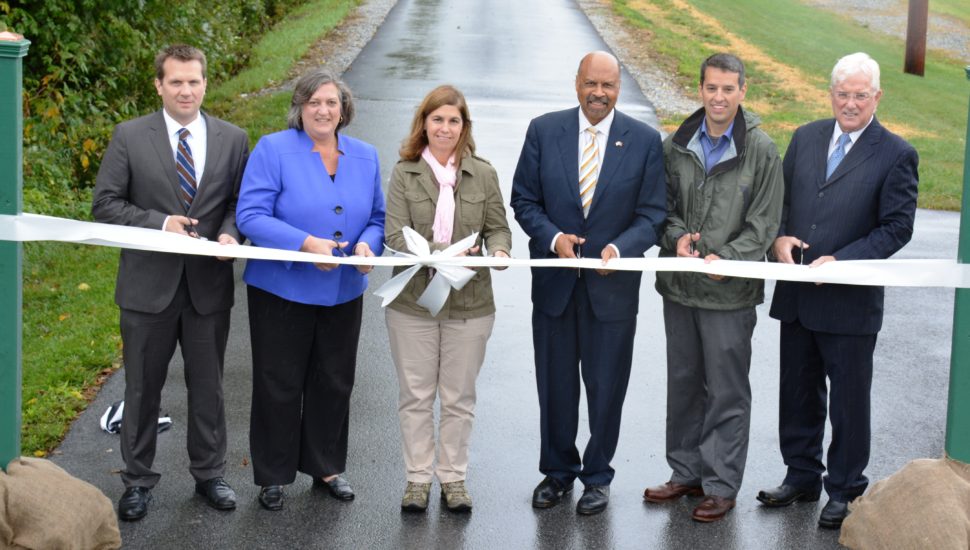OP-ED: Chester County Has Trails — Now We Need Rails

By Barry Rabin
When it comes to trails, Chester County is wonderful.
I had this thought a few months ago when my family and I were biking on the newly-extended Chester Valley Trail, where you can now hop on in Exton and bike all the way to King of Prussia.
As we passed through the Great Valley area, where the trail parallels Route 202, I had another thought: How ironic it was that we were traveling the very same route on which jammed traffic and wasted time reign daily during the rush hours (I don’t say “rush hour” anymore, because there isn’t just one hour of rush in Chester County these days).
As wonderful as our new trails are – thanks to our county and local governments and the other organizations that made them a reality – here’s what we don’t have in Chester County: Rapid transit that zips people quickly from their homes to their workplaces and back every day.
The irony is that, while Chester County’s population has increased exponentially in the past few decades, we have actually dismantled more rail lines than we have built.
The result? Jammed traffic, which results in wasted time, lost productivity at work, lost family time at home, increased stress, reduced physical exercise, increased use of fossil fuels, increased air pollution, and increased commuting costs due to low gas mileage and extra wear on our vehicles.
The fact is that Chester County had more active “light rail” lines in the 1920s than it has today, despite the fact that the population then was a small fraction of what it is today.
As the automobile became popular in the mid-1960s, rail lines and trolley lines were shut down in favor of cars. And cars were a great way to get to work and back for many years in Chester County, where traffic jams were so unknown that Chester County roads were almost never mentioned on the radio traffic reports.
Chester County does have a couple of rail lines, chief among them SEPTA’s Paoli-Thorndale line (formerly the R-5). But while many trains run on this route, this line follows the commuter patterns of early in the last century, not this one.
For most of the last century, a typical Chester County commuter lived in Paoli or Malvern and worked in Center City Philadelphia. This explains the “hub and spoke” pattern of our existing rain lines.
Today, a Chester County commuter is more likely to be working in places like Great Valley, King of Prussia or Conshohocken. And these commuting paths, ironically, are some of the same routes where we have torn out most of the railroad tracks.
In West Chester, where the population has exploded over the past few years, they actually closed down the commuter rail line, despite the fact that many more people would benefit from it today than did 20 or 30 years ago.
It’s true that highways such as Route 202 are being widened, something that will provide temporary relief. But history tells us that taking out one traffic bottleneck eventually just moves the bottleneck farther out, as people start to build homes farther away from their workplaces (since the traffic is now moving again). Witness the explosion of residential development west of Exton after the Exton Bypass was completed.
The sad part is that this problem doesn’t stem from a lack of know-how or technology. Light rail has been around for a century. Yet we have barely utilized it in our area.
Even something as quick and efficient as a monorail, which was touted at the 1964 New York World’s Fair as the “commuting technology of the future,” has been relegated to the status of an amusement park curiosity at places like Disneyworld (at least in the U.S.).
The problem, instead, stems from the misplaced priorities of our governmental units, particularly the federal government.
We live in a country that recently spent more than a trillion dollars on two wars halfway across the world (including, oddly enough, spending millions trying to build up their infrastructure), with nary a word spoken about whether or not we could afford it.
Yet that same government refuses to spend a tiny fraction of that amount to get people back and forth quickly between work and home, despite the fact that this is essential to the daily lives of millions of Americans.
In Chester and Montgomery Counties, a planned rail line known as the “Schuylkill Valley Metro,” which would have roughly paralleled Route 422 (a highway that’s often jammed during commuting hours) was scrapped because it couldn’t get funding. Yet it could have been built for what we spent in a week on the war in Iraq.
In Chester County, our governmental and business leaders, along with organizations like the Transportation Management Association of Chester County (TMACC), have tried to address some of these traffic issues. But their solutions have been largely limited to busses, transit vans and other highway-based vehicles that are still at the mercy of jammed traffic.
So what can be done to fix this?
We need to start making it clear to our local officials that rapid transit is a top priority, and that the economic and environmental cost of jammed traffic more than justify the funds that would be spent. And our local officials in turn need to appeal to the state and federal governments for assistance on this (especially the feds, since they are the ones who would likely have to come up with the lion’s share of the construction money).
In doing this, we need to remember that “federal funds” aren’t the government’s money. They’re our money. And we need to make it clear to our leaders that we want it spent on rapid transit, not carpet bombing.
If the past decade was Chester County’s “Decade of Trails,” the coming decade (starting right now) needs to be its “Decade of Rails.”
———–
Barry Rabin is an attorney and writer based in Chester County. He welcomes your comments at Rabinwrites@aol.com.
Connect With Your Community
Subscribe to stay informed!
"*" indicates required fields





































![95000-1023_ACJ_BannerAd[1]](https://vista.today/wp-content/uploads/2023/03/95000-1023_ACJ_BannerAd1.jpg)










